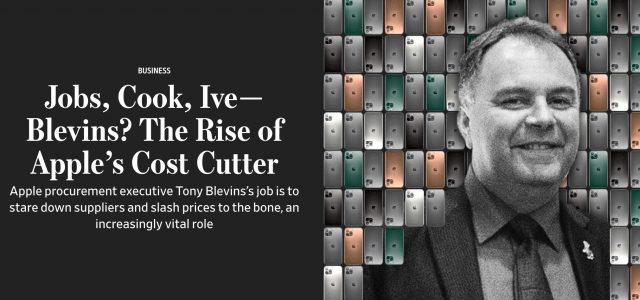Tony Blevins: Tim Cook’s Cost Cutter
As iPhone sales growth slows, it’s becoming increasingly important for Apple to lower supply costs to maintain its profit margins. That’s where Apple’s Vice President of Procurement Tony Blevins steps in. Tripp Mickle of the Wall Street Journal profiled Blevins and his hardball tactics to get the best deals for Apple (if you can’t get past the Wall Street Journal paywall, AppleInsider has a good summary).
 Apple has had a tumultuous relationship with Qualcomm over modem chip, and Blevins has been in the middle of it all:
Apple has had a tumultuous relationship with Qualcomm over modem chip, and Blevins has been in the middle of it all:
At Qualcomm, which has dealt frequently with Mr. Blevins, executives found him friendly when asking for favors, calculating when pressing for lower prices and punishing when Qualcomm defied his demands.
Blevins has saved Apple hundreds of millions of dollars with tactics like inviting multiple glass suppliers for Apple’s new corporate campus to a Hong Kong hotel, putting them in separate conference rooms, and then bouncing from room to room, often with bluffed numbers. He’s also responsible for enforcing Apple’s strict non-disclosure policies, violations of which can open suppliers up to penalties of $50 million or more.
Before you judge Blevins or Apple harshly for such strong-arm tactics, it’s important to realize that the business world is often brutal, such that every large, successful company has—and needs—high-level executives like Blevins.
The inevitable result of success.
Once the market is saturated, there are only a few choices (and good companies should probably do all of them):
Once the market is saturated, there are only a few choices (and good companies should probably do all of them):
One of the reasons why I like the article Josh linked to is that it proves why this is not necessarily true, especially when it comes to Apple. Blevins is clearly cutting costs without sacrificing quality, and most of the time, making major quality improvements while cutting costs and benefiting the bottom line. In addition to Qualcomm and other the excellent examples that are not discussed is the problems Apple was having with Intel’s chip development. Cook and Blevins solved it by rolling Apple’s own more advanced A chips.
Though iPod was the ultimate coolest entertainment product when it was introduced, it wasn’t until iTunes and a PC version rolled out that it became what was then an unstoppable force of nature. Hasta la vista Walkman. But Steve Jobs was brilliant, creative and savvy enough to change the world with iPhone even though he knew it would result in a swift and painful death for iPod.
IIRC, Apple rolled its own face recognition technology from day one, causing Samsung, etc. to scramble to cobble licensed systems together that still don’t work as well as Apple’s.
A company can expand within existing markets. Just one example is how Apple significantly grew their sales in the notoriously difficult Chinese market this past quarter by expanding their retail presence and services. But an even better example is Disney, who everyone thought was loosing his marbles when he began licensing Mickey Mouse watches, toys, dishes, books, etc. in the 1930s at the height of the Great Depression, and then developing theme parks and hotels and going into TV production after WWII. And in the late 1950s, Disney pioneered the first color TV series and specials, then expanding into live action movies and theater.
Like Disney, Steve Jobs, Tim Cook and Tony Blevins have been relentless cost cutters and supply side bargainers focused on technology, creativity and the bottom line.